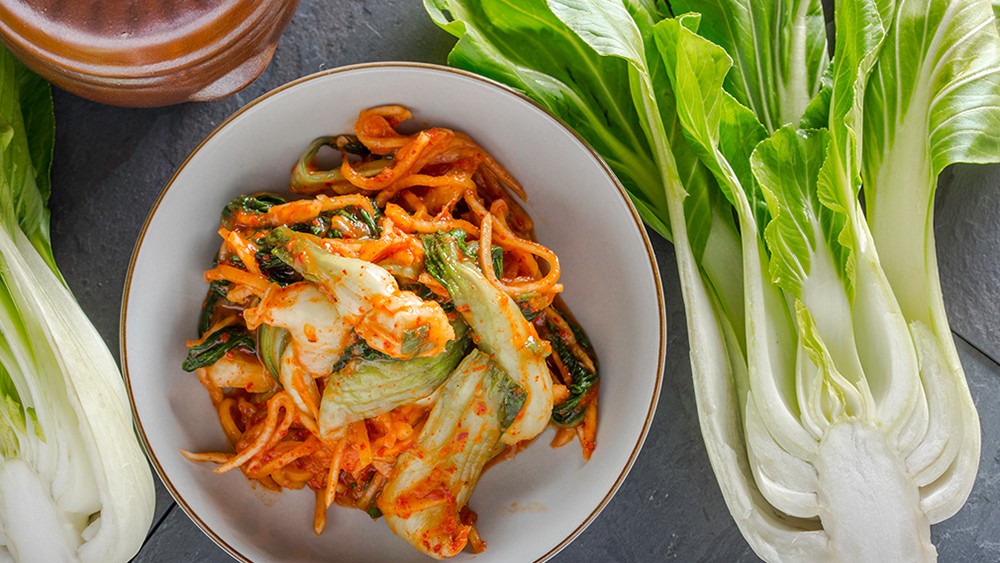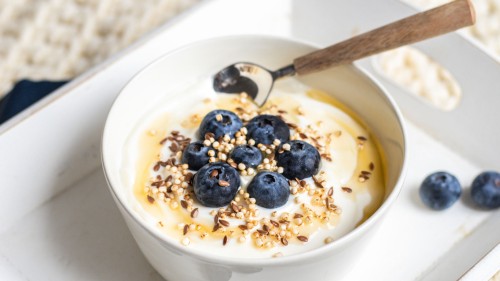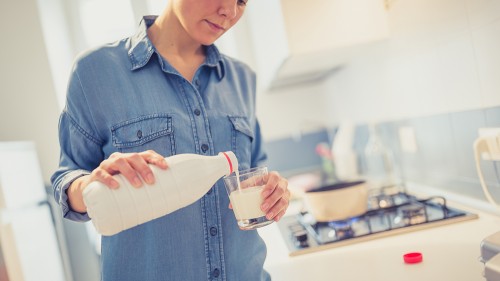Prebiotics vs. Probiotics: Difference, Benefits, Sources, and FAQs
Last Updated on January 12, 2022
Medically Reviewed by Anthony Dugarte, MD
Probiotics and prebiotics – what’s the difference and do you need both? We break it all down, including how they can help your microbiome.


A lot of recent research has been devoted to the gut microbiome, the living world of microorganisms that reside in every person’s intestine.
Scientists used to think these microbes had little purpose, but evidence now shows that a healthy microbiome provides benefits to several aspects of health. (1)
To keep the gut microbiome working its best, including probiotics and prebiotics in the diet is helpful. But what exactly are these things, and why are they important?
Gaining a general understanding of the microbiome, prebiotics, and probiotics can be a motivating step toward setting dietary health goals.
How Does a Gut Microbiome Develop?
Before explaining prebiotics and probiotics, it’s helpful to understand the microbiome itself.
The gut microbiome is the large variety of microorganisms, including bacteria, yeasts, and viruses, that live in your lower gastrointestinal tract.
A few of them can be harmful and cause problems, but most live within their hosts peacefully and can even contribute to good health.
Everyone on earth has a unique population of microbes based on exposures from the moment of birth. The first exposures come from the mother during birth and breastfeeding, and then from the environment in which the person is raised.
Humans continue to pick up different species of microbes throughout life.
From dog kisses to hands going unwashed before dinner, germs that enter the mouth can potentially contribute to the gut flora.
People can also lose valuable members of our microflora during bouts of illness, due to poor eating habits, and with antibiotic treatments.
On average, scientists think most healthy people have around 1000 different species of microbes symbiotically living within our intestinal tract. (2)
Summary
Each person has a unique population of microbes living symbiotically with them in the gut. The microbiome begins forming at birth and continues throughout the lifespan.
Benefits of the Microbiome
Research shows that the integrity of the microbiome affects many aspects of health.
This includes the digestive and immune systems, brain function, mental health, and even the fight against obesity. (3)
Scientists are just beginning to understand how it all works.
For starters, the microbiome acts as a barrier against infection.
Like a packed subway station that doesn’t have room to allow people off the train, simply having a robust number of friendly microbes living on the intestine walls can crowd out harmful bacteria and viruses. (4)
When there’s no room for viral and bacterial villains to take up residence, they are forced to move along and out of the gut through the feces.
Some microbes produce short-chain fatty acids, further strengthening the gut wall barrier and protecting the body from potential invaders. (5)
Certain microbes have been shown to produce mood-enhancing neurotransmitters like dopamine, norepinephrine, and serotonin. These chemicals can be responsible for improving mental health. (6, 7)
Still, other microbes produce nutrients like vitamin K, which is important for bone strength and blood clotting. This vitamin K production also seems to be a key to fighting symptoms among Crohn’s Disease patients. (8)
Summary
Research shows that the microbiome is helpful to the human body in several ways.
Probiotics vs. Prebiotics: What Are They and What’s the Difference?
With growing evidence proving the microbiome’s importance, researchers are looking for ways to improve its population and health.
Evidence shows that we can improve gut health by including probiotics and prebiotics in the diet.
But what are they exactly?
The terms probiotics and prebiotics have official definitions set by the International Scientific Association for Probiotics and Prebiotics (ISAPP). (9)
Probiotics
Probiotics are defined as “live microorganisms that, when administered in adequate amounts, confer a health benefit on the host.”
From a consumer perspective, probiotics are microorganisms that either naturally grow in or are added to foods we can eat.
When a doctor recommends it, probiotics can also be purchased in supplement form.
To be clear, the specific species of microbes in the food or supplement must have been scientifically proven to benefit the human body in some way to be officially considered a probiotic.
Adding probiotics to the diet may improve the population of the microbiome, depending on whether the body was in need of that specific probiotic.
Prebiotics
Prebiotics are defined as “a substrate that is selectively utilized by host microorganisms conferring a health benefit.”
In other words, prebiotics are food for the beneficial microflora in your gut.
Without prebiotics, probiotics cannot thrive, and the microbiome will weaken.
Prebiotics are available in supplement form but can be more reliably provided to your gut flora by eating a healthy, fiber-rich diet.
Prebiotics are generally found in high-fiber foods that humans can’t fully digest themselves. However, the fiber can be broken down and metabolized for us by those clever little microbes, keeping them healthy and able to reproduce.
So, probiotics and prebiotics are two very different things. Comparing them is like comparing people to broccoli.
Probiotics are living organisms, and prebiotics are the food probiotics need to thrive.
Summary
Probiotics and prebiotics are found in foods and supplements and can be beneficial to health by enriching the gut microbiome.
The distinction is that probiotics are live beneficial microorganisms and prebiotics are the fiber that feeds those beneficial microorganisms.
What Are Synbiotics?
Synbiotics are a more recent term on the supplement scene. The prefix “syn” means “together,” and synbiotics are a combination of probiotics and prebiotics. (10)
Knowing that probiotics thrive best on their favorite prebiotic fibers, some supplements are now being sold in this combination with mixed results.
Unless they’re specifically recommended by your health care professional, at this time it may be more reliable to get both probiotics and prebiotics from foods.
Related: Ritual Synbiotic+ Review
Benefits of Probiotics
Getting probiotics from fermented foods can be a normal part of a healthy diet. Eaten regularly, these foods can offer the benefit of keeping body systems strong by adding good bacteria to the existing microbiome.
Sometimes doctors may recommend specific additional probiotics in the form of supplements. Supplemental probiotics have sometimes been found to benefit people who:
- Have taken antibiotics and need to replenish the good bacteria in the gut
- Need help fighting infectious diarrhea
- Need relief from irritable bowel syndrome
- Suffer from constipation (11)
- Suffer from lactose intolerance
People who suffer from these ailments and illnesses have sometimes found relief from symptoms by increasing probiotics in their diets.
Because the supplement scene can be confusing, ask your doctor for specific recommendations if you think you need a supplemental probiotic.
One thing to note, the effects of probiotic strains found in research studies are very specific.
These benefits cannot be extended to other strains of the same genus or even to other strains belonging to the same species and sub-species.
Sometimes, specific strains in a supplement are not studied or differ slightly from the ones in the research.
Benefits of Prebiotics
Like all living things, our gut microbiome can’t live and flourish without nutrition and energy from food.
People can eat a variety of probiotic foods or take supplements, but without adding prebiotic foods, the microbes can’t survive and reproduce.
Because prebiotics happen to be plant foods like fruits, vegetables, and whole grains, they have the bonus benefit of high nutritional value.
These foods offer a wealth of vitamins and minerals to humans in addition to the food they provide for their gut flora.
Probiotics Food Sources
While the word “probiotics” is somewhat new, foods with probiotics have been consumed by humans for thousands of years.
Almost every culture around the world has developed its own probiotic foods. Some of these foods include:
-
Kimchi: Fermented cabbage and other vegetables, originated in Korea at least three thousand years ago. Kimchi offers several strains of lactic acid bacteria. (12)
-
Kefir: Originated in western Asia and is loaded with dozens of probiotic species. It’s made by fermenting goat, cow, or sheep milk. (13)
-
Kombucha: Fermented tea and likely originated in China. While some animal studies show that kombucha has health benefits, human studies are limited. (14)
-
Yogurt: Origin is unknown but may have come from Mesopotamia as early as 5000BC. Several species of lactic acid bacteria and bifidobacteria make yogurt a probiotic food, and brands with a “Live and Active Cultures” seal indicate that it had at least 100 million cultures per gram when it was made. (15, 16)
-
Sauerkraut: Has a German name but is thought to have been invented by slaves when they built the Great Wall of China using rice wine and cabbage. Look for unpasteurized, refrigerated varieties that advertise live cultures in the product. (17)
-
Miso: Fermented soybeans, a Japanese probiotic food that can also be considered a prebiotic. The fungus, Aspergillus oryzae, in miso feeds Blautia coccoides in the gut, a species of bacterium that is thought to increase longevity. (18, 19)
-
Pickled Cucumbers: Thought to have originated in India. Like sauerkraut, probiotic pickles are the less common refrigerated variety. Shelf-stable pickles do not contain live cultures. (20)
Keep in mind that although food is regulated by the FDA, the viable number and species of probiotics in probiotic foods can vary significantly based on recipes, brand standards, and even handling during processing, shipping, and storage.
Summary
There are many probiotic foods that have originated worldwide that have been consumed by humans for thousands of years.
Prebiotics Food Sources
Prebiotics are substances we can eat that also feed our microbiome.
We’re only beginning to learn which foods are best for feeding each microbe species, but we know that they are generally high-fiber plant foods, including fruits, vegetables, legumes, seeds, nuts, and whole grains.
Some high-fiber foods contain particular kinds of fiber that humans can’t digest, but our gut microflora needs to thrive. Some experts call this type of fiber nondigestible fermentable carbohydrates.
Although many plant foods have fiber, not all of them have been studied well enough to consider them prebiotic guarantees.
Eating a wide variety of the following foods listed in the evidence-based book, Gut Insight, by Jo Ann Hattner, MPH, RD, can help ensure that your microbiome is well fed.
Some of these foods include:
-
Vegetables: Spinach, mustard greens, dandelion greens, chard, collard greens, yacon, tomato, sweet potato, shallot, salsify, onion, mushrooms, leeks, jicama, Jerusalem artichoke, konjac, hearts of palm, garlic, dahlia tuber, chicory root, cabbage, burdock, broccoli, asparagus, artichoke
-
Fruits: Wild blueberries, raisins, pomegranate, passion fruit, nopal, kiwifruit, guava, cranberry, camu-camu fruit, berries, banana, apple, agave, acai
-
Legumes: Soybeans, peas, lentils, dry beans, chickpeas
-
Grains: Whole wheat, wheat bran, rye, rice bran, oats, millet, corn, buckwheat, barley
-
Seeds and Nuts: Walnut, rapeseed, pistachio, peanut, flaxseed, chestnut, cashew apple, almond
-
Other Foods: Green tea, oolong tea, black tea, seaweed, honey, cassava, cocoa
As you can see, the list of foods is varied and long, which gives people a lot of plant foods from which to choose. Eating a variety is important because each microbe species seems to thrive on different foods.
Some of these foods are commonly found in the U.S., while others may not be familiar to many consumers. Ask your local grocer if you need help finding them in your favorite store.
Summary
Many plant foods are considered prebiotics. Eating a wide variety of these foods can help keep your gut microbiome nourished so that it can thrive.
Frequently Asked Questions
Is it better to get probiotics from supplements or foods?
For most healthy people, getting probiotics by eating various fermented foods is an adequate way to add beneficial microbes to the gut microbiome and help keep your gut working its best.
Foods are regulated by the FDA and offer nutrients in addition to the probiotics they host.
Doctors may recommend a probiotic supplement for some people who need help with specific medical problems like constipation, irritable bowel syndrome, infectious diarrhea, and lactose intolerance.
These problems only respond to specific probiotics, so always consult a doctor before buying supplements.
Which prebiotic foods are best?
While some prebiotic foods like onions, garlic, and bananas have been more extensively studied than others, no one prebiotic food is necessarily better than others.
Different microbes thrive on different prebiotic foods, so eating a wide variety of them is best.
What things are bad for the microbiome?
Having an unhealthy microbiome is called dysbiosis. This can be caused by exposure to substances that are toxic to your microbiome.
People who drink a lot of alcohol, smoke, and take antibiotics unnecessarily are at risk. (21, 22)
The best foods for your microbiome seem to be whole plant foods in a wide variety.
Dysbiosis can be caused by limiting your foods, especially if those choices are high-fat, highly processed foods that are not plant-based. Such foods offer little or no nutrition for your microbiome population. (23)
How long will it take to improve my gut microbiome once I begin eating probiotic and prebiotic foods?
Depending on the existing health of your gut microbiome, you may be improving your microbe population from the moment your food enters the gut.
Bacteria live a very short lifespan, and adding good bacteria and foods that feed them to your intestinal tract regularly may improve the microflora within a short amount of time.
How do I know which probiotic microbe I need?
It used to be nearly impossible to know which microbes were missing from a person’s gut because testing was rare and hard to find.
However, with the study of the gut microbiome rapidly progressing, research is opening doors for new companies and labs that are able to analyze fecal samples.
Keep in mind that the science behind fecal analysis is uncertain, and many doctors are still skeptical about it.
If you are experiencing health problems and would like to have your gut microbiome analyzed, discuss the possibility with your doctor for legitimate recommendations.
Be wary of online companies that may be fraudulent scams.
The Bottom Line
Every human’s gut microbiome is a unique makeup of microbes that begins populating at birth and continues to diversify throughout life.
People may have little control over certain factors that affect the health of the microbiome over the lifespan, including early childhood and environmental exposures, illnesses, and the need for antibiotic treatment.
However, people do have control over what they eat.
Regularly eating fermented foods containing probiotics (microbes that benefit human health) has been shown to improve the gut microbiome population.
Adding prebiotics, or substances found in foods that feed probiotic microbes is another great way to help keep your gut healthy.
Prebiotics can be found in a wide variety of plant foods, including fruits, vegetables, legumes, nuts, and seeds.
Probiotics and prebiotics can be purchased in supplement form, but the vast choices of supplements on the market can be confusing.
A doctor should be consulted before beginning any new medications or supplements to ensure it’s right for you.
At WellnessVerge, we only use reputable sources, including peer-reviewed medical journals and well-respected academic institutions.
- The role of the microbiome for human health: from basic science to clinical applications:
https://www.ncbi.nlm.nih.gov/pmc/articles/PMC5962619/ - Role of the gut microbiota in health and chronic gastrointestinal disease: understanding a hidden metabolic organ:
https://www.ncbi.nlm.nih.gov/pmc/articles/PMC3667473/ - The Influence of the Gut Microbiome on Obesity in Adults and the Role of Probiotics, Prebiotics, and Synbiotics for Weight Loss:
https://www.ncbi.nlm.nih.gov/pmc/articles/PMC7333005/ - Intestinal barrier and gut microbiota: Shaping our immune responses throughout life:
https://www.ncbi.nlm.nih.gov/pmc/articles/PMC5788425/ - Short chain fatty acids in human gut and metabolic health:
https://pubmed.ncbi.nlm.nih.gov/32865024/ - Neurotransmitter modulation by the gut microbiota:
https://www.ncbi.nlm.nih.gov/pmc/articles/PMC6005194/ - The Gut Microbiome and Mental Health: What Should We Tell Our Patients?:
https://journals.sagepub.com/doi/10.1177/0706743719874168 - Diversity of Gut Microbiota Affecting Serum Level of Undercarboxylated Osteocalcin in Patients with Crohn’s Disease:
https://www.ncbi.nlm.nih.gov/pmc/articles/PMC6683014/ - International Scientific Association for Probiotics and Prebiotics:
https://isappscience.org/ - Synbiotics:
https://isappscience.org/wp-content/uploads/2020/08/Synbiotics-infographic.pdf - The effect of probiotics on functional constipation in adults: a systematic review and meta-analysis of randomized controlled trials:
https://academic.oup.com/ajcn/article/100/4/1075/4576460 - Science Direct: Kimchi:
https://www.sciencedirect.com/topics/food-science/kimchi - Milk kefir: composition, microbial cultures, biological activities, and related products:
https://www.ncbi.nlm.nih.gov/pmc/articles/PMC4626640/ - Kombucha: a systematic review of the empirical evidence of human health benefit:
https://pubmed.ncbi.nlm.nih.gov/30527803/ - Bifidobacteria and Their Role as Members of the Human Gut Microbiota:
https://www.ncbi.nlm.nih.gov/pmc/articles/PMC4908950/ - IDFA: Live & Active Cultures Seal:
https://www.idfa.org/live-active-cultures-seal - DNA Fingerprinting of Lactic Acid Bacteria in Sauerkraut Fermentations:
https://www.ncbi.nlm.nih.gov/pmc/articles/PMC2168044/#:~:text=Historically%2C%20four%20species%20of%20lactic,Pediococcus%20pentosaceus%2C%20and%20Lactobacillus%20plantarum. - Review of the health benefits of habitual consumption of miso soup: focus on the effects on sympathetic nerve activity, blood pressure, and heart rate:
https://www.ncbi.nlm.nih.gov/pmc/articles/PMC7461326/ - Japanese traditional dietary fungus koji Aspergillus oryzae functions as a prebiotic for Blautia coccoides through glycosylceramide: Japanese dietary fungus koji is a new prebiotic:
https://www.ncbi.nlm.nih.gov/pmc/articles/PMC4980852/ - Three novel Bacillus strains from a traditional lacto-fermented pickle as potential probiotics:
https://sfamjournals.onlinelibrary.wiley.com/doi/10.1111/jam.13901 - The Gastrointestinal Microbiome:
https://www.ncbi.nlm.nih.gov/pmc/articles/PMC4590619/ - The Association Between Smoking and Gut Microbiome in Bangladesh:
https://www.ncbi.nlm.nih.gov/pmc/articles/PMC7364824/ - Influence of diet on the gut microbiome and implications for human health:
https://www.ncbi.nlm.nih.gov/pmc/articles/PMC5385025/






